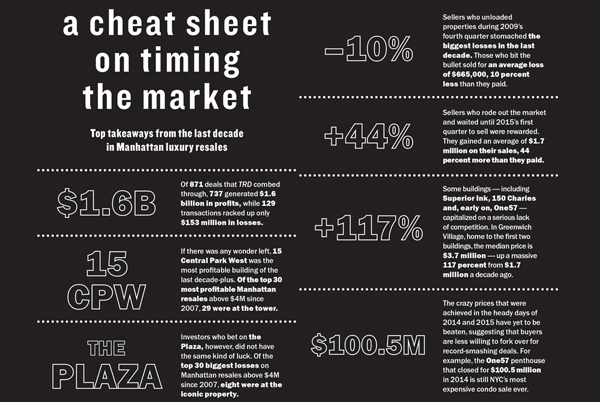This month, as the market slide continues, The Real Deal traced the arc of the Manhattan luxury market, analyzing nearly 900 resale transactions between January 2007 and June 2017.
We zeroed in on condos south of 96th Street that sold and then resold for $4 million or higher to pinpoint the best times to buy and sell during that decade-long stretch — and to determine who timed the market best and who got burned.
What we discovered was that the absolute best time to sell (and worst time to buy) was 2015’s first quarter — when prices were peaking. Of the 44 deals that closed during that period, owners sold for an average gain of $1.7 million, or about 44 percent more than they paid.
On the flip side, the worst time to sell (and best time to buy) was 2009’s fourth quarter — when prices had bottomed out. Of the 61 deals that closed during that period, owners sold for an average loss of roughly $665,000, or about 10 percent less than they paid.
Interestingly, the vast majority of resales over the past decade were profitable for investors. Of the 871 deals that TRD analyzed, 737 generated $1.6 billion in profits for buyers. Investors only lost a combined $153 million on 129 deals. Manhattan’s biggest gains and losses have been in the new-development sector, which has seen a major run-up in prices since the last recession.
“The thought process for new development has been this idea that when you buy in, you’re in the money,” said Adam Modlin, one of the brokers tapped to market the Getty, a planned condo designed by Peter Marino near the High Line. “By the time you close, [the property] appreciates.”
But in many ways, the buyers who fueled the frenzy by paying record-setting prices may now have the most to lose.
“Prices have escalated to the point where by the time you buy in, you’re buying in at premium value,” Modlin said. “There’s no positive outlook for immediate appreciation.”
